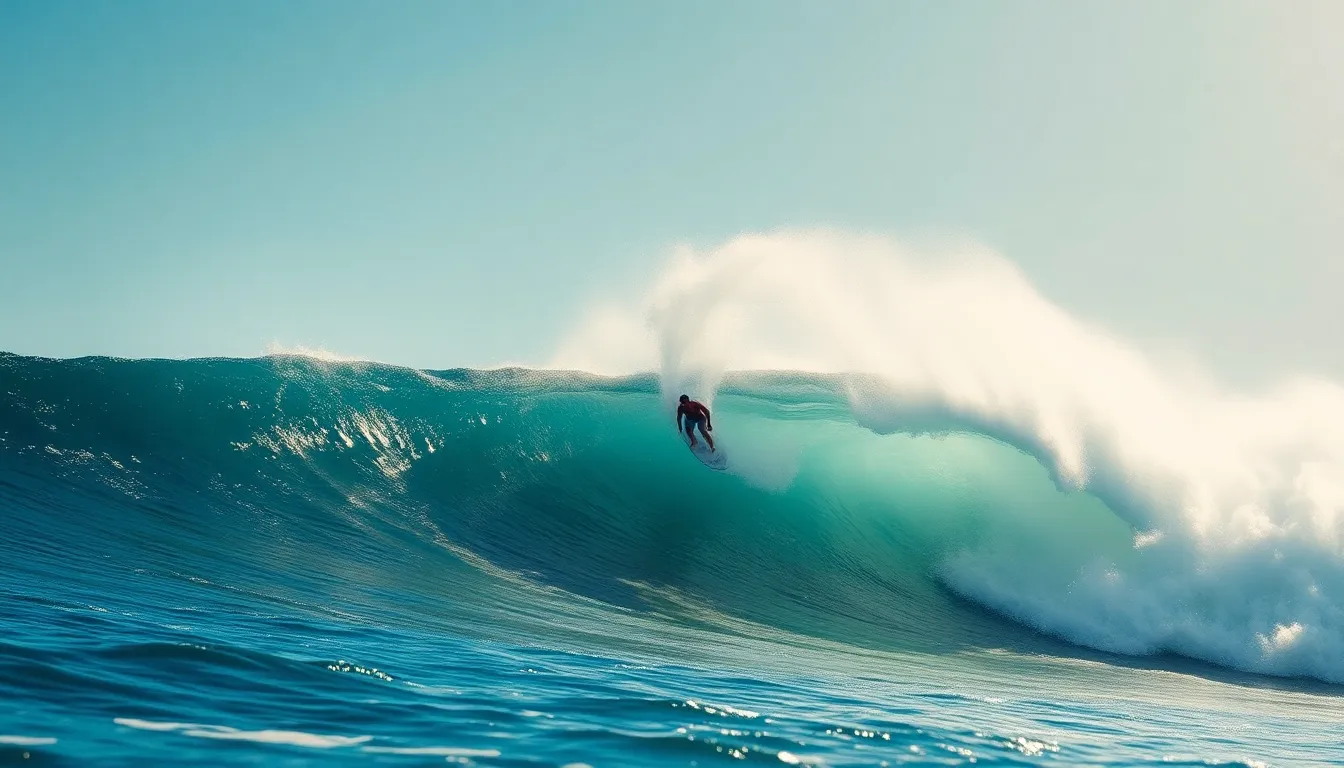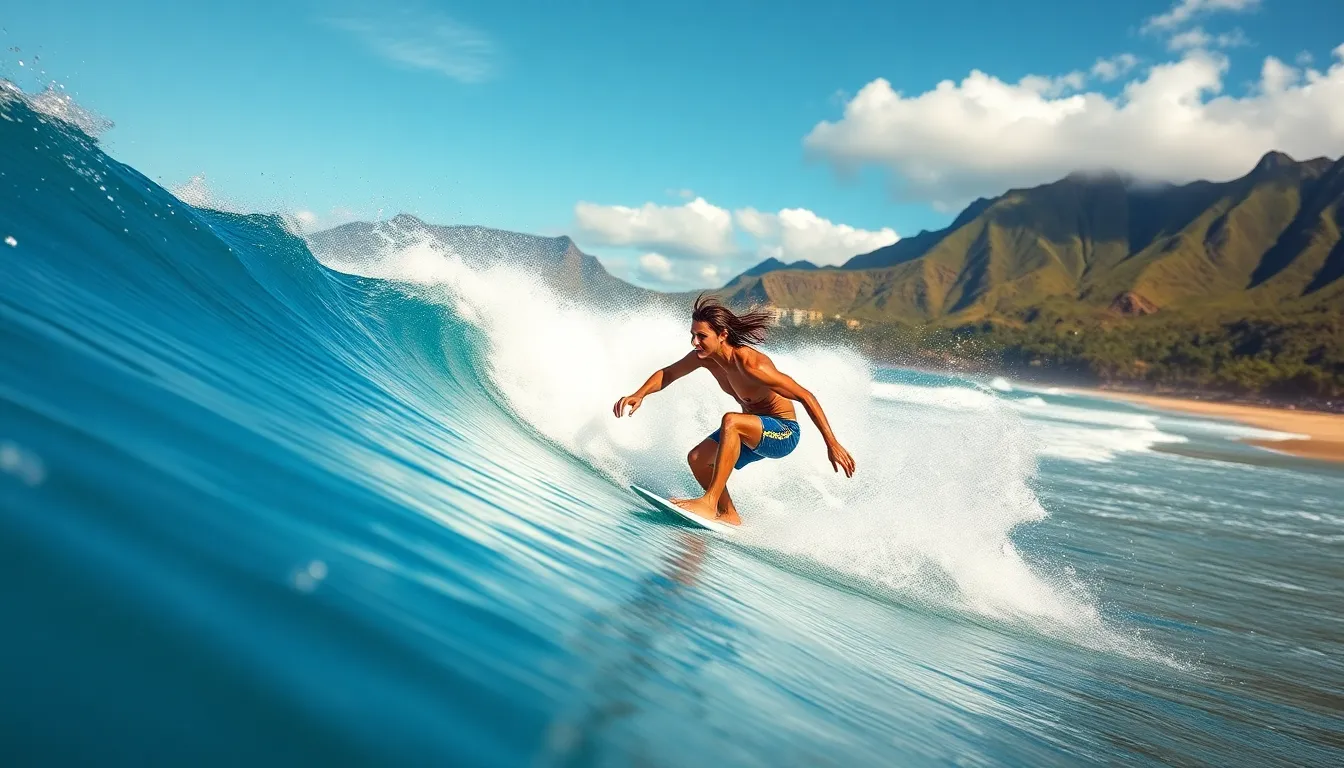Table of Contents
ToggleHawaii, the birthplace of surfing, offers some of the most breathtaking waves and stunning beaches in the world. From the iconic North Shore of Oahu to the mellow swells of Maui, surfers of all skill levels flock to these islands for an unforgettable experience. Whether you’re a seasoned pro or a beginner eager to catch your first wave, Hawaii’s surf scene has something for everyone.
Navigating the diverse surf spots can be overwhelming, but with the right guidance, anyone can find their perfect wave. This guide will explore essential tips, popular surf locations, and local etiquette to ensure a safe and enjoyable surfing adventure. Get ready to dive into the vibrant culture and thrilling waters that make Hawaii a surfer’s paradise.
Overview of Hawaii Surfing
Hawaii stands as the birthplace of surfing, offering diverse waves that cater to all skill levels. The islands present iconic surf spots, notable for their beauty and unique challenges.
Key Surfing Locations
- North Shore of Oahu: Renowned for its powerful winter swells, this area attracts pro surfers aiming for world-class waves. Locations like Waimea Bay and Pipeline are particularly famous.
- Maui: Home to spots like Ho’okipa Beach and Lahaina, Maui features consistent waves ideal for both beginners and advanced surfers.
- Kauai: With less crowded conditions, spots such as Hanalei Bay and Barking Sands provide a more relaxed surfing experience.
- Big Island: Kailua-Kona offers diverse conditions, catering to various skill sets, with both beach and reef breaks.
Surfing Conditions
- Season Variations: Winter months deliver larger swells, while summer provides smaller, more manageable waves.
- Wind and Tide: Localized wind patterns and tidal changes greatly influence wave quality. Early morning often offers the best conditions.
Surfer Etiquette
- Respect Local Surfers: Acknowledge locals and their claim to the waves, especially in crowded areas.
- Understanding Priority: Always yield to the surfer closest to the peak and take turns to ensure a safe and enjoyable surf session.
- Cleanup: Maintain cleanliness at surf spots by disposing of trash properly. Environmental awareness is vital to preserve these spots.
Essential Tips
- Gear Rentals: Multiple surf shops across the islands offer rental boards and gear, allowing novices to try surfing with ease.
- Surf Lessons: Beginners should consider taking lessons from local surf schools, ensuring safety and proper technique.
Hawaii’s vibrant surfing culture combines stunning landscapes with a strong sense of community. Surfers experience both thrill and respect while riding the waves in these legendary waters.
Best Surf Spots in Hawaii

Hawaii offers diverse surf spots that cater to every skill level, ensuring an unforgettable surfing experience. Here are the highlights of the best surfing locations throughout the islands.
Oahu’s North Shore
Oahu’s North Shore is famous for its massive winter swells and legendary surf breaks. Surfers flock to:
- Pipeline: Known for its powerful and hollow waves, this spot is ideal for experienced surfers. The wave breaks over a shallow reef, making it both thrilling and challenging.
- Waimea Bay: This iconic beach hosts big wave competitions during winter months, attracting top surfers worldwide. It features waves reaching up to 30 feet, making it a must-visit for advanced surfers.
- Sunset Beach: With a variety of waves suitable for different skill levels, this beach offers long rides and is perfect for both seasoned surfers and those honing their skills.
Maui’s Famous Waves
Maui boasts consistent waves and scenic beaches, drawing surfers year-round. Key spots include:
- Ho’okipa Beach: Renowned for its clean waves and reliable conditions, this beach is favored by both windsurfers and surfers. The east-facing shore often provides great surfing throughout the year.
- Lahaina: This area features multiple surf breaks, including several ideal for beginners. Its warm waters and gentle waves make it an inviting destination for those just starting out.
- Cannon Beach: A lesser-known spot that offers good swells, Cannon Beach is perfect for surfers seeking a less crowded experience. The waves here work best during summer months.
Big Island Surf Locations
- Kailua-Kona: Home to diverse conditions, Kailua-Kona offers suitable waves for all skill levels. Surfers enjoy a mix of tranquil beaches and more challenging breaks, allowing for versatile surfing experiences.
- Punaluu Black Sand Beach: This beach provides an unconventional surfing backdrop with black sand and gentle waves. Best suited for beginners, it allows newcomers to practice in a stunning environment.
- Hilo Bay: Known for its consistent conditions, Hilo Bay features various breaks that accommodate different skill levels. This location often experiences smaller swells, making it perfect for less experienced surfers.
Surfing Conditions and Seasons
Hawaii offers unique surfing conditions throughout the year, influenced by its distinct seasons and weather patterns. Understanding these factors is crucial for safety and maximizing the surfing experience.
Ideal Surf Seasons
The best surfing seasons can be attributed to varying swells. Late fall through early spring (November to April) produces larger, powerful waves, especially on the North Shore of Oahu. This period attracts experienced surfers seeking adrenaline-pumping conditions. In contrast, summer (May to October) features smaller, more manageable waves accessible for novices. Maui sees consistent surf year-round, though it’s optimal during summer months for less experienced surfers. Additionally, the Big Island offers diverse conditions throughout the year, catering to all skill levels depending on the season.
Weather Impact on Surfing
Weather plays a significant role in shaping surfing conditions. Wind patterns, particularly trade winds, affect wave shape and consistency. Early mornings often present the calmest conditions, leading to smoother rides. Localized weather phenomena, such as storms, can enhance wave quality, but they also introduce hazards. Surfers should monitor tide schedules as high tides may create challenging surf conditions, while low tides can reveal rocky areas. Understanding these weather influences enhances the ability to select the right spot and timing for a successful surf outing.
Surf Schools and Rentals
Hawaii offers numerous surf schools and rental shops, catering to surfers at all skill levels. Whether a newcomer or an experienced rider, ample resources are available to enhance the surfing experience.
Beginner Surf Lessons
Beginner surf lessons are widely available across Hawaii’s beaches. Schools, such as the Hawaiian Surf School and Surf HNL, provide experienced instructors who focus on safety and technique. Lessons typically include equipment usage, wave etiquette, and ocean awareness. Most classes accommodate small groups, ensuring personalized attention. The average lesson lasts about 2 to 3 hours, allowing ample time to practice paddling, balancing, and catching waves.
Equipment Rental Options
Various rental options exist for surfing gear throughout Hawaii. Local surf shops, including Sunset Surf Shop and Maui Wave Riders, offer a range of equipment, from boards to wetsuits. Rental prices generally range from $20 to $50 per day, depending on the board type and size. Many shops provide package deals for multiple days, making rentals more economical. Additionally, many locations offer delivery services, bringing boards directly to the beach. Some shops provide complimentary lessons or guided tours with equipment rentals, creating a comprehensive surfing experience.
Tips for Surfing in Hawaii
Surfing in Hawaii requires awareness of safety practices and adherence to local etiquette. These considerations enhance the experience and ensure a respectful atmosphere among surfers.
Safety Considerations
Understanding safety is crucial when surfing in Hawaii. Strong currents and shore breaks may pose risks, particularly for inexperienced surfers. Local lifeguards monitor many popular beaches and can provide assistance. Wearing a leash secures the surfboard, preventing it from becoming a hazard to others. Utilizing sunscreen protects against intense UV exposure. Be mindful of the environment, including marine life; for example, avoiding contact with jellyfish and sea urchins is advisable. It’s best to surf with a buddy, especially in unfamiliar waters. Checking weather and surf reports before heading out ensures readiness for changing conditions.
Local Surf Etiquette
Respecting local surf etiquette enhances camaraderie among surfers. Heeding the rules of wave priority is essential; the surfer closest to the peak typically holds the right of way. Always communicate with other surfers, signaling intentions to prevent collisions. Dropping in on another surfer’s wave is considered disrespectful. Acknowledging local surfers and their customs fosters goodwill. Maintaining cleanliness at surf spots, including proper disposal of trash, preserves the natural beauty of the beaches. Being patient and waiting for one’s turn in the lineup demonstrates respect within the surfing community.
Hawaii stands as a premier destination for surfers around the globe. Its diverse surf spots cater to all skill levels, ensuring everyone can find their perfect wave. From the powerful breaks on Oahu’s North Shore to the more relaxed conditions in Kauai, each location offers a unique experience.
Surfers should embrace the local culture by respecting etiquette and safety practices. By doing so, they contribute to a positive environment that enhances the joy of surfing. Whether one is a beginner or an experienced rider, Hawaii’s waves promise an unforgettable adventure. With the right preparation and respect for the ocean, every surfer can enjoy the thrill of riding in these legendary waters.




